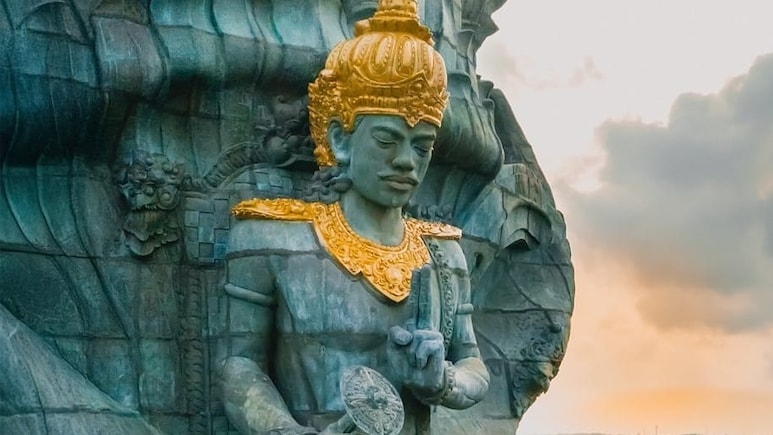
If you thought the tallest statues of Hindu deities could only be found in India, Bali has a surprise in store. Rising majestically over the limestone cliffs of Bukit Ungasan is the Garuda Wisnu Kencana (GWK) statue - a colossal depiction of Lord Vishnu riding his loyal companion, Garuda. The statue is located in the Garuda Wisnu Kencana Cultural Park, Bali, Indonesia.
More than just a visual marvel, this monument is a proud emblem of Indonesia's cultural depth, spiritual heritage, and architectural ambition. This year, from August 13-17, 2025, the park will host the Pesta Rakyat to mark Indonesia's Independence Day, culminating in a grand music concert on August 17.
Story Behind Building The Tallest Lord Vishnu Statue In Bali
The idea for GWK was born in the 1980s, not as a mere tourist attraction but as a national icon. Construction began in 1997, faced long pauses due to financial challenges, and finally reached completion in 2018. Today, the statue stands 121 metres (nearly 400 feet) tall with a 64-metre (210 feet) wingspan, overtaking even New York's Statue of Liberty in height.
Built with over 3,000 tons of copper and brass, GWK's size and complexity demanded ingenious engineering solutions to endure Bali's tropical weather and seismic activity.
Why Lord Vishnu's Tallest Statue Stands In Bali
In Hindu belief, Vishnu is the preserver of the universe, and Garuda - part eagle, part mythical guardian - symbolises freedom, courage, and loyalty. Together, they convey a powerful message: the eternal guardianship of nature and the world. This theme resonates deeply in Indonesia, where Garuda, specifically the Garuda Pancasila, is also the national emblem. This Lord Vishnu statue celebrates unity and diversity while preserving mythological traditions that have shaped Balinese culture for centuries.
The History Of Hinduism And The Worship Of Hindu Gods In Bali
Hinduism reached Bali more than 2,000 years ago through ancient maritime trade between India and Southeast Asia. Over time, it intertwined with local beliefs and Javanese culture, resulting in the unique form of Hinduism seen today. Temples (pura) and daily offerings (banten) remain a central part of Balinese life, reflecting a deep connection to both spirituality and the natural environment.
Also Read: Why Bali Is One Of The Most Popular Holiday Destinations For Indian Travellers
Exploring The GWK Cultural Park
The GWK Cultural Park has a lot more to offer beyond this monumental statue:
- Cultural Performances: Traditional Balinese dances run daily, offering an intimate look at the island's spiritual stories.
- Art And Architecture: The grounds are dotted with stone sculptures and mythological scenes.
- Food With a View: Jendela Bali restaurant serves both local and international dishes, paired with panoramic island vistas.
- Festivals And Events: From music concerts to cultural parades, the park is a lively hub of celebration.
Location And How to Get To The GWK Cultural Park
The GWK Cultural Park sits in Ungasan, South Kuta, Badung Regency, Bali, just 10-15 minutes from Ngurah Rai International Airport and around 30 minutes from Kuta.
From Airport:
- Taxi: 10-15 minutes direct ride.
- Private Car: Hire with a driver for comfort.
From Kuta, Seminyak, Nusa Dua:
- Car/Motorbike: Follow Ngurah Rai Bypass to Uluwatu.
- Taxi/Ride Apps: Gojek and Grab are easily available.
Best Time To Visit The GWK Cultural Park
The park is open daily from 9 am to 11 pm.
- Morning (9 am - 1 pm): Cooler weather, lighter crowds, and early performances.
- Late Afternoon (4 - 6 pm): Golden light for photography, Balinese Cultural Parade, and a perfect lead-in to the Kecak dance at 6 pm.
- Evening (After 6:30 pm): Serene night views with dramatic lighting, ideal for dinner at Jendela Bali.
Ticket Information For The GWK Cultural Park
Regular entry costs IDR 150,000 (Rs 808 approx). This includes:
- Access to GWK Cultural Park
- Free ASANA Artseum entry
- Complimentary drink at Jendela Bali
- All cultural performances (around 15 shows)
- Animated film screening at Garuda Sineloka Mini Theatre
Garuda Wisnu Kencana Statue: An Iconic Landmark Worth Visiting
Whether you see it from the air while landing in Bali or stand at its base, the Garuda Wisnu Kencana statue is awe-inspiring. It is seen as a living celebration of history, myth, and identity, embodying the heart of Bali's culture and the artistry of its people.
Track Latest News Live on NDTV.com and get news updates from India and around the world

